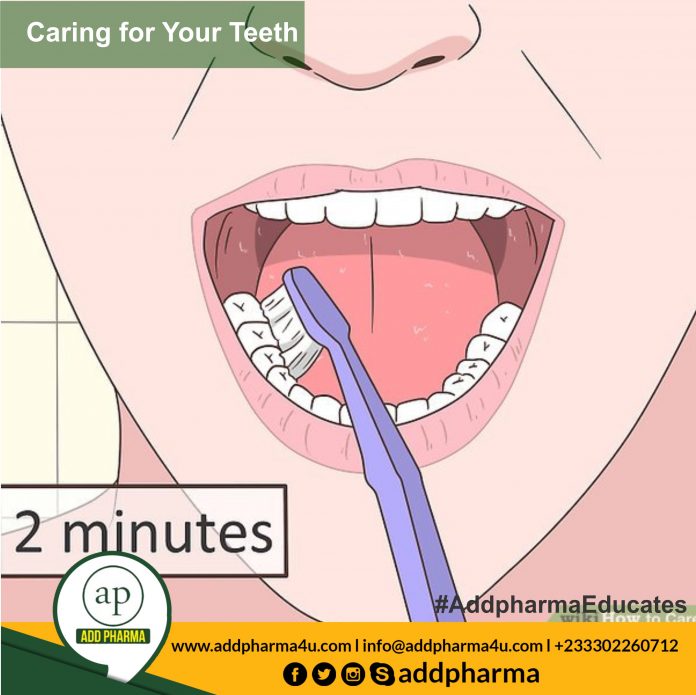Taking good care of your teeth will help you live a long, healthy, pain-free life. In order to keep your teeth healthy, it is important to develop a good dental care routine early in life and maintain your teeth as you get older. You can do this by practicing good oral hygiene, eating a healthy diet, and supplementing these good habits with professional care when necessary
1
Brush each morning and each evening. When you brush you should do so for at least two minutes. This will give you the time you need to get to all surfaces of your teeth. Make sure you remember the backs of your teeth.
- Teach your children good oral hygiene habits by having them start brushing as soon as they get their first baby teeth. Cavities in baby teeth will be just as uncomfortable as cavities in permanent teeth.
- For best results, use a soft bristled brush or an electric toothbrush. Whichever type of toothbrush you use, be sure to replace it every three months. If you are concerned that your toothbrush might be worn out earlier, you can inspect it to see if the bristles are bent and damaged. If so, you may want to replace it.
- Brushing regularly will not only give you healthy, pain-free teeth, but it will also keep your breath fresh. But don’t brush too soon after eating. After you eat your mouth is more acidic and this makes the enamel temporarily softer. Wait at least 30 minutes before brushing.

2
Use a fluoride toothpaste. Fluoride protects the enamel and makes you less likely to get cavities. But it is important that the toothpaste have enough fluoride to be effective. Check to make sure it has at least 1,350 – 1,500 ppm.
- Toothpastes with less than 1,000 ppm of fluoride will be ineffective at protecting your teeth.
- Children can use full strength toothpaste if an adult makes sure they spit it out after brushing.

3
Floss daily. Flossing cleans the surfaces between your teeth. This is important because you can’t clean there effectively with your toothbrush. As a result, if you don’t floss, food, plaque, and bacteria build up there.
- Use 30 cm of floss or an interdental cleaner. Insert it between your teeth and curve it around one of the teeth. Move it up and down along the side of the tooth, then curve around the other tooth and repeat.
- Use a floss pick if you have trouble using the classic method.
- Be gentle when you go below the gum line. If you are new to flossing, your gums may bleed, but after a few days, this will stop.

4
Use mouthwash. Look for a mouthwash that has fluoride in it. If you use a fluoride mouthwash after brushing and flossing, this will help the fluoride reach the enamel of all surfaces of your teeth. Swish the mouthwash around in your mouth for two minutes to allow it to thoroughly coat all areas of your teeth.
- Chlorhexidine is also a protective substance found in some mouthwashes, which fights against bacteria and has a slight remineralizing effect.
- You can also make a natural remedy using a salt solution. Put half teaspoon of salt into a glass of warm water and stir.
- Don’t swallow the mouthwash because it may upset your stomach. If you want to try to kill bacteria further back in your throat, you can gargle briefly before spitting it out.

5
Brush or scrape your tongue. The surface of your tongue is uneven. This means that food particles and bacteria often get trapped there. This then becomes a source of bacteria which gets transferred to your teeth.
- You can brush gently or use a special tongue scraper. Some toothbrushes even have a rough, rubbery patch on the back which you can use for this purpose.
- Scrape gently so that you don’t injure your tongue. It shouldn’t hurt. When you finish, rinse your mouth out to get rid of the debris and bacteria.

6
Don’t smoke. Smoking will stain your teeth yellow, give you bad breath, and make you more likely to get gum disease or mouth cancers. If you need help quitting smoking, there are many resources available. You can:
- Get support from friends, family, or a support group
- Avoid situations where you habitually smoke
- Call a hotline when you are having cravings
- Talk to your doctor or see an addictions counselor
- Try nicotine replacement therapy
- Get residential treatment in a treatment center






























